Ski Slope
It is time to hit the slopes, and race! What does it take to go from the beginner slope to being a downhill pro?
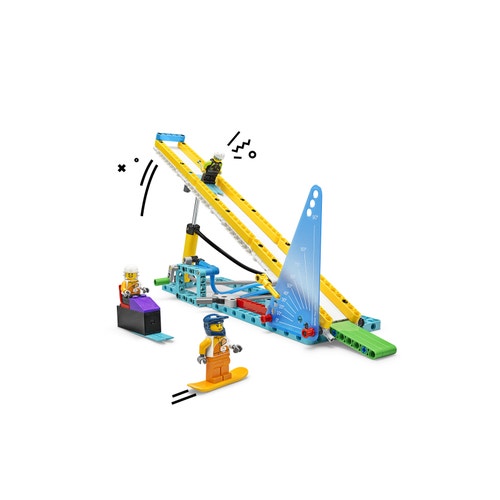
Prepare
- Review the online pupil material. Use a projector to share this material with your pupils during the lesson.
- Make sure that you have covered Newton's second law of motion in an earlier lesson.
- Consider the abilities and backgrounds of all your pupils. Differentiate the lesson to make it accessible to everyone. See the Differentiation section below for suggestions.
Engage
(Whole Class, 5 Minutes)
- Watch the pupil video here or access it via the online pupil material.
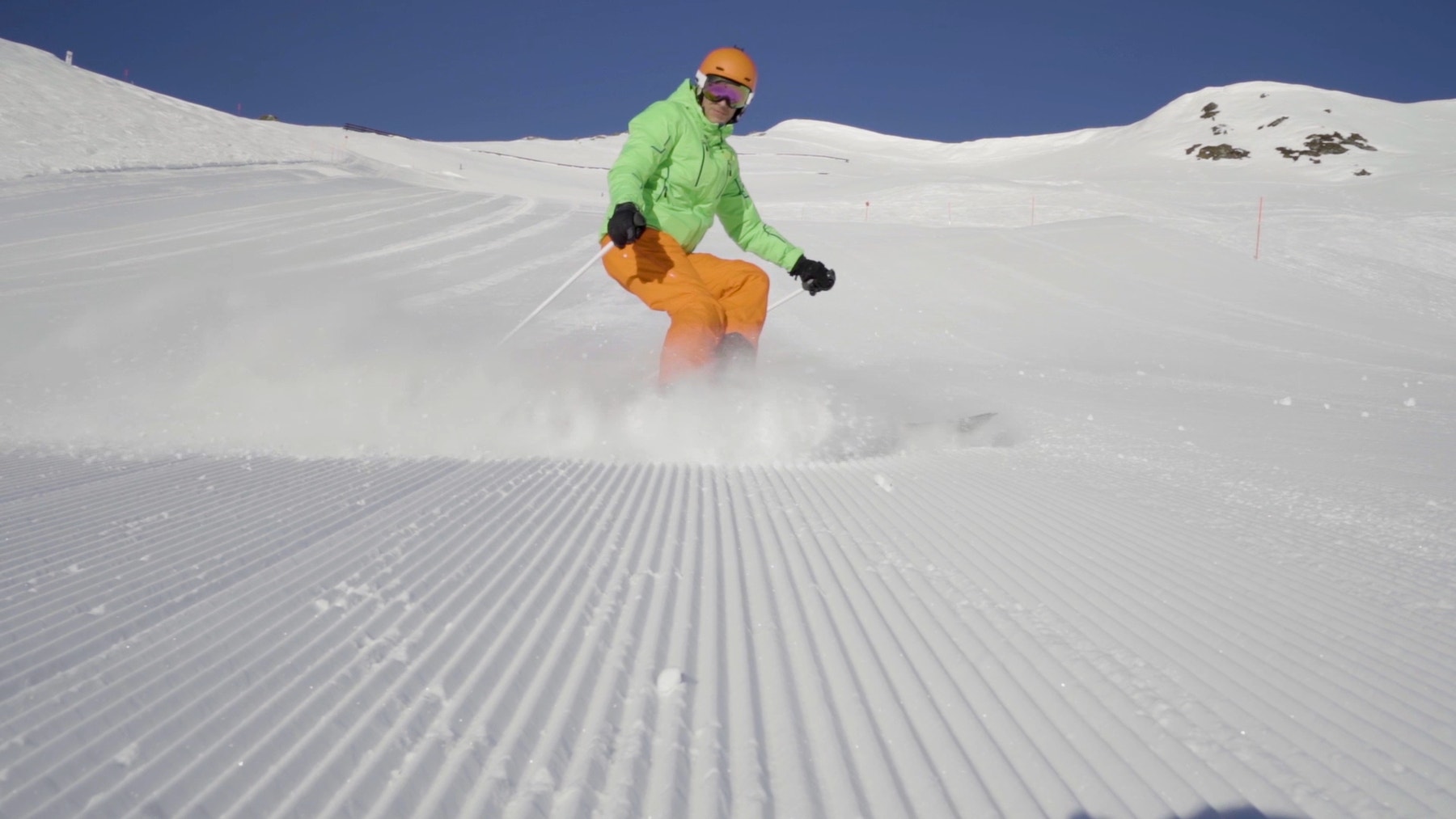
- Facilitate a quick discussion about the forces that affect a skier on a ski slope.
- Ask questions like these:
- Which force*(s)* make a skier move down a slope? (Gravity)
- How does weight effect a skier's motion? (More weight causes more momentum.)
- Tell the pupils that they’re going to build a model of a downhill ski slope.
- Distribute a set to each group.
Explore
(Small Groups, 30 Minutes)
- Ask the pupils to work in pairs to build the Ski Slope model. Tell them to take turns, one partner searching for the bricks while the other builds, switching roles after each step has been done.
- You can find building help in the Tips section below.
- Have everyone stop building after 20 minutes. By this point, they should have at least built the skiers and the ramp with the scale for measuring angles (up to step 25 on page 47). If time permits, they can add the pneumatic system later.
- Tell the pupils to find a smooth surface that is at least 1 meter long and to place their models at one end.
- Demonstrate how to ensure a fair test of the skiers. You can refer to this as the ‘inertial frame of reference’.
- Ask: Would this experiment be the same if you did it on an aeroplane travelling at 500 mph? (Yes. Even in this classroom, it feels like we are standing still, but the earth is rotating at close to 1000 mph/1600 kph. If your inertial frame of reference is this room, then the model is moving slowly. If your inertial frame of reference is the sun, then it is moving super-fast).
Experiment 1:
- Ask the pupils to set the angle of the ski slope to 20 degrees and slide the skiers down one at a time.
- Tell them to measure the distance travelled by each skier and to mark it on their Student Worksheets or in their science notebooks. It is best if they make 3 or more runs for each skier and calculate the average distance for each.
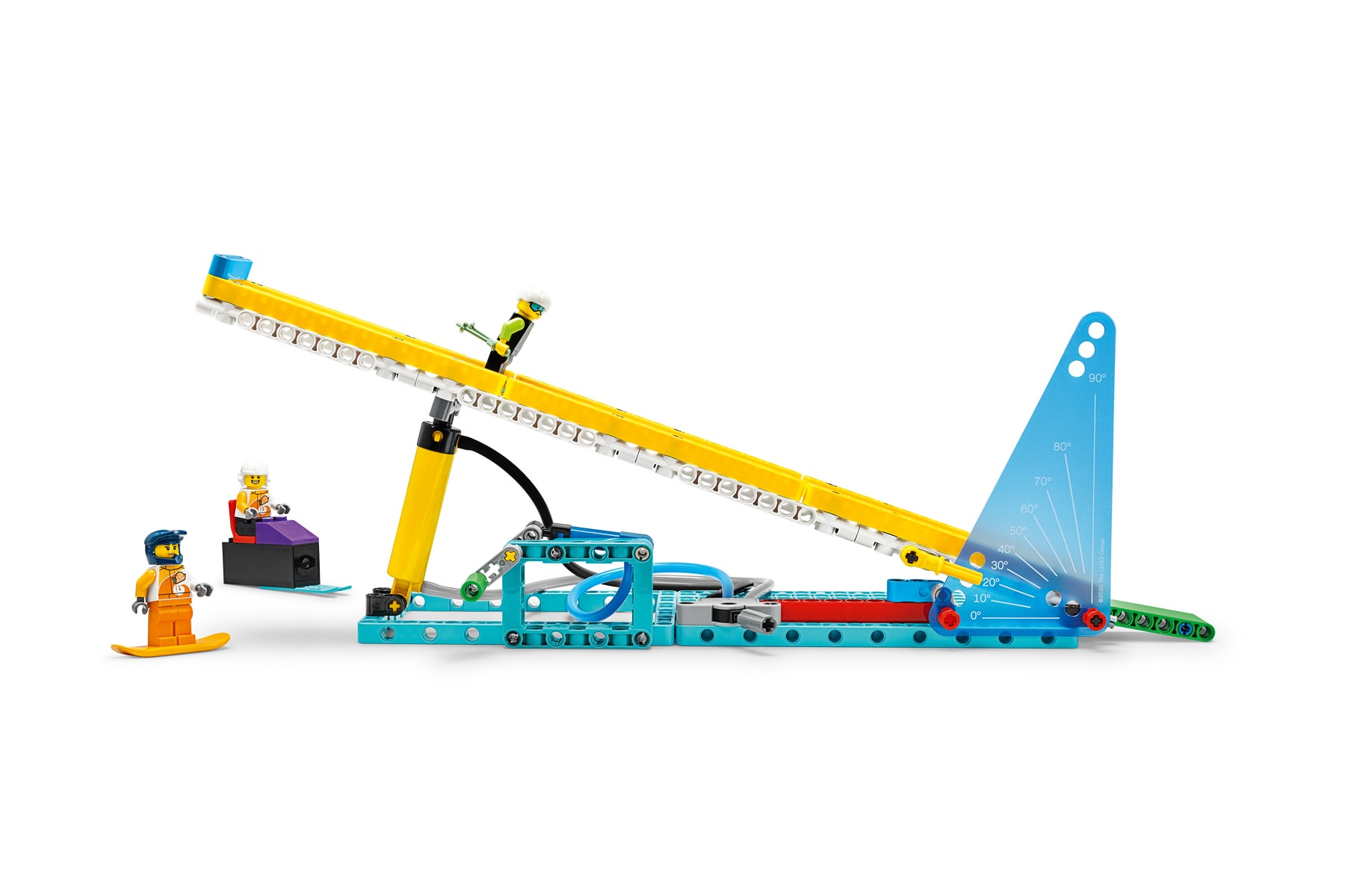
Explain
(Whole Class, 5 Minutes)
- Gather your pupils together to share what they have built.
- Ask questions like these:
- Why did the heavier skier go the farthest? (The heavier skier has more mass, so it will have more momentum and keep sliding for longer.)
- What would happen if you removed the skis from the heavier skier?
- Have the pupils gather around one of the models, and demonstrate that it will go a shorter distance. (The curved skis vs a sharp rectangular corner affects the distance that the skier travels because they reduce friction as the skier slides off the bottom of the slope.)
Experiment 2:
- Now have your pupils set the angle of the ski slope to 30 degrees and predict where they think each skier will finish. They can do this by placing different coloured bricks beside the measuring tape.
- Ask them to slide each skier down the ramp to see if their predictions were correct. Tell them to calculate an average distance for each skier, as they did in the previous experiment. Remind them to record the distances on their Student Worksheets (Teacher Support – Additional Resources) or in their science notebooks.
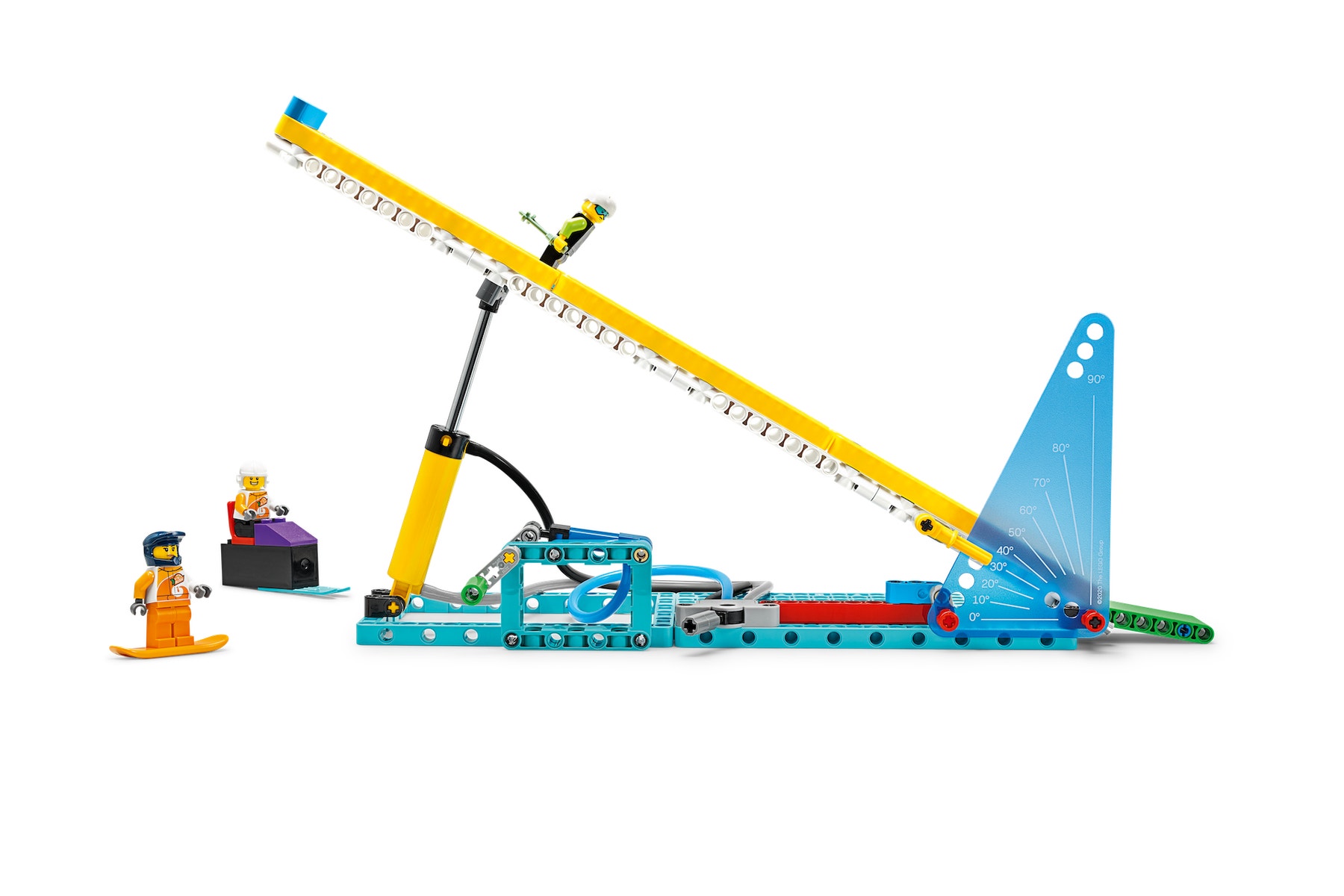
Elaborate
(Whole Class, 5 Minutes)
- Gather your pupils together to review and discuss the results of their experiments.
- Ask questions like these:
- What patterns did you recognise in the skiers' motion when you changed the height of the slope (The higher the angle of the slope, the farther the skiers travelled.)
- Were you able to predict what would happen next?
- If time permits, encourage the pupils to describe the phenomenon in their own words in their science notebooks.
- Allow time for the pupils to disassemble their models, sort the bricks back into the trays and tidy up their workstations.
Evaluate
(Ongoing Throughout the Lesson)
- Encourage your pupils to explore their models’ movement as they build them.
- Can they use the pneumatic pump controlled by the hand crank to make the ramp move up and down?
- Give feedback on each pupil's performance.
- Facilitate self-assessment.
- To simplify the process, you can use the assessment rubrics that have been provided.
Observation Checklist
- Measure your pupils’ proficiency in describing that larger forces cause more significant changes in motion than smaller forces.
- Establish a scale that suits your needs. For example:
- Requires additional support
- Can work independently
- Can teach others
Self-Assessment
- Have each pupil choose the brick that they feel best represents their performance.
- Green: With some help, I can describe how more momentum causes a bigger change in motion.
- Blue: I can describe how more momentum causes a bigger change in motion.
- Purple: I can explain how and why more momentum causes a bigger change in motion.
Peer Feedback
- Encourage your pupils to assess their peers by:
- Using the brick scale above to score each other's performance
- Presenting their ideas and giving constructive feedback
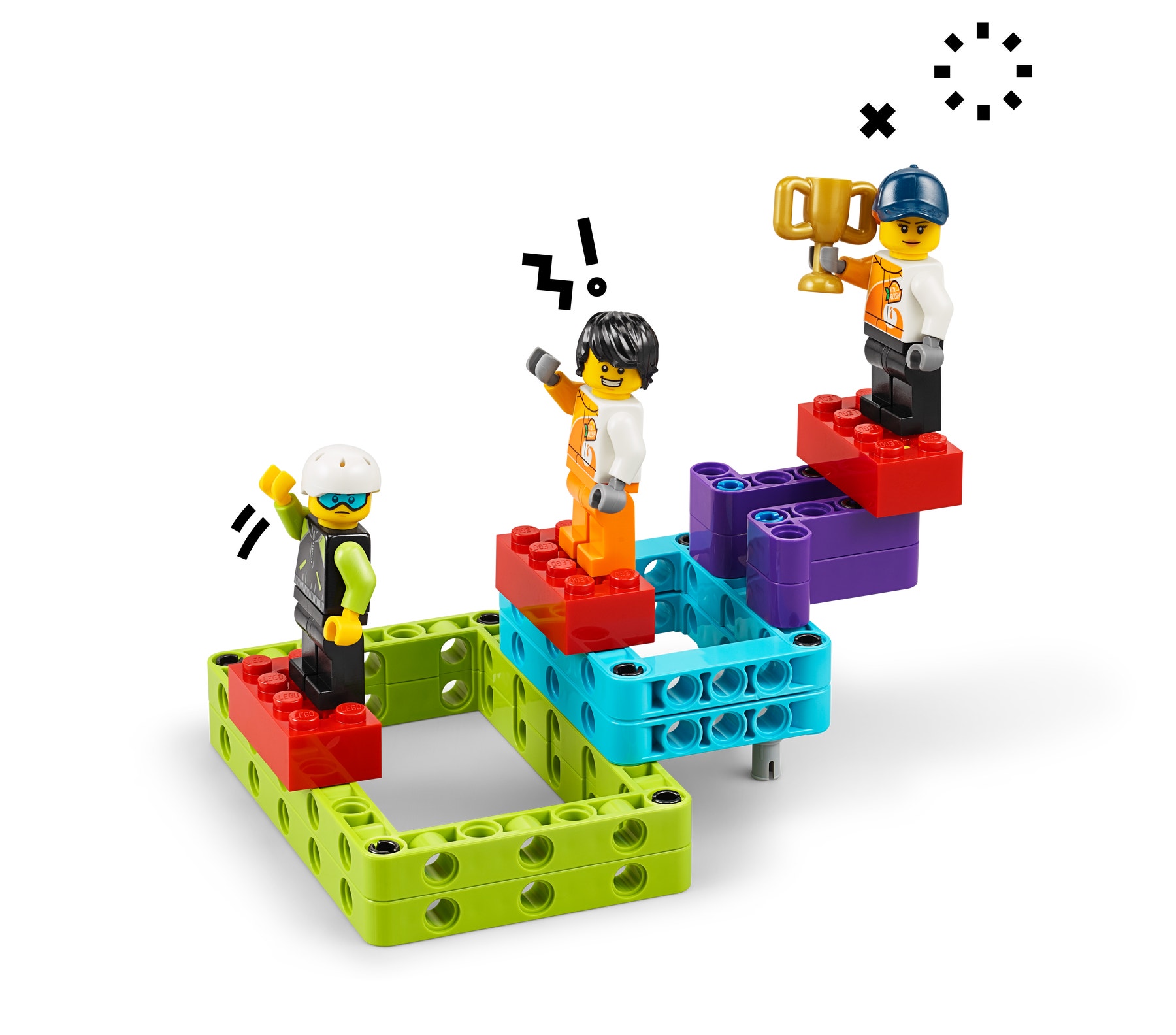
Tips
Model Tips
- The pupils will have to use a strip of tape to mark a start line. Alternatively, they can line their models up with a mark on the table or floor to ensure that the ski slope stays in the same position each time that they test.
- To launch each skier, the pupils should place it at the top of the ski slope and let go. The models are different lengths, so have the pupils measure from the top of the slope to where each skier stops.
Differentiation
Simplify this lesson by:
- Having your pupils explore the motion of just one skier from the 2 different angles
Increase the difficulty by:
- Having the pupils try the experiment again on a different surface (e.g. with a large sheet of paper in front of the ski slope)
- For an extra challenge, have them remove the skis from the heavier skier and see what happens
- Challenging your pupils to build their own skiers, make predictions and test their models to see if they can go even farther
Extensions
(Note: This will require additional time.)
To incorporate the development of maths skills, ask your pupils to calculate and compare the momentum of each skier:
- P (Momentum), M (Mass), V (Velocity)
- P = M x V
- (Small skier) P1 = 5g x ? m/s
- (Large skier) P2 = 62g x ? m/s
- V = V (acceleration due to gravity is the same for both, with minor differences in sliding friction, but we can assume that the speed of each is very similar)
- P2 > P1
ACMNA179
Solve simple linear equations
Teacher Support
The pupils will:
- Explore how forces effect changes in a skier's motion on ski slopes of different heights
- Explore the relationship between the mass and motion of an object on an inclined plane
- Understand what is meant by inertial frame of reference
- LEGO® Education BricQ Motion Prime Sets (one for every two pupils)
- Masking tape
- Measuring tape (one per group)
National Curriculum
Sc5/1.1
Planning different types of scientific enquiries to answer questions, including recognising and controlling variables where necessary
Sc5/1.2
Taking measurements, using a range of scientific equipment, with increasing accuracy and precision
Sc5/1.5
Reporting and presenting findings from enquiries, including conclusions, causal relationships and explanations of results, in oral and written forms such as displays and other presentations
Sc5/4.2a
Explain that unsupported objects fall towards the Earth because of the force of gravity acting between the Earth and the falling object
Sc5/4.2b
Identify the effects of air resistance, water resistance and friction, that act between moving surfaces
Ma5/3.1g
Use all four operations to solve problems involving measure using decimal notation including scaling
Ma6/2.5a
Use simple formulae
Ma6/2.5c
Express missing number problems algebraically
Ma6/3.1a
Solve problems involving the calculation and conversion of units of measure, using decimal notation up to 2 decimal places where appropriate